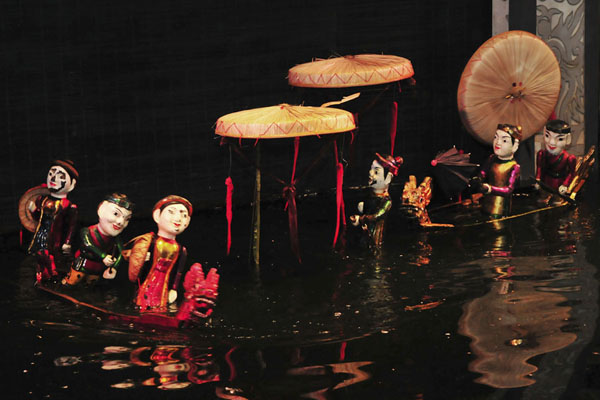 |
|
The age-old water puppet performances still thrive in Vietnam thanks to efforts from local troupes and the government. [Photo/China Daily] |
HANOI - On a summer afternoon in Vietnam's capital, Hanoi, the audience watches colorful puppets in the form of a farmer, fish, fox or dragon plowing a rice field, swimming, climbing a tree or puffing fire and smoke on the surface of water with no sign of handlers or equipment.
While many traditional performing arts are facing extinction, water puppetry, which dates back nearly a millennium, has become increasingly well-supported both domestically and abroad as a distinctive art form in Vietnam.
The surface of a pool of water is the performance area, which serves not only to hide the puppeteers and the puppets' strings but also to create a reflective stage providing natural amplification for the singing puppeteers accompanied by percussion music and firecrackers.
The stage, constructed of bamboo, resembles a traditional village's communal house where villagers gather for important events.
Because of its special stage, this art also needs unique "actors". The puppets range from 28 to 45 centimeters and are usually made from the wood of fig trees, which is light and tough.
The figures are then painted with seven layers of waterproof paint.
The plays generally use a selection of some 30 traditional repertoires, which include Teu dancing, buffalo fighting, plowing, duck tending, fox hunting, boat racing, dragon dancing and chess playing - all of which reflect either daily agricultural life or the wars of national heroes against foreign invaders.
When the curtain is raised, the stock character, Teu - the village buffoon with a plump body and a humorous smile - enters the stage in an unfastened shirt showing his round belly and introduces the play with a song.
After that, he sets off a string of firecrackers. Then the main play begins: An old fisherman is sitting in a boat dropping his line into the water and a fish rises to the bait and squirms, or a little boy sits atop his buffalo and plays the flute.
"The show has given me a better understanding of the cultural relationship between the people and waterways here," says Naomi Liner, an Australian visitor in Hanoi.